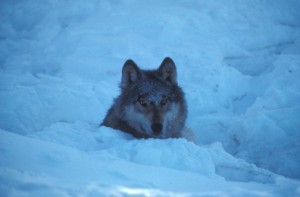Lone wolf goes the distance
September 1, 2011
907-474-7468
9/1/2011
Somewhere in the rolling tundra east of Deadhorse, a lone wolf hunts. The 100-pound male will take anything it can catch, or find a ptarmigan, a darting tundra rodent, a fish, the scraps of a carcass, or, if lucky, a moose calf or caribou. Hunger is a common companion, but the wolf somehow survived when his mate probably died of it last winter.
That event may have triggered the lone wolf’s incredible summer journey from south of the Yukon River to the crumbling shores of the Beaufort Sea. The wolf has traveled about 1,500 miles in four months, according to biologist John Burch, who works for the National Park Service.

Burch has studied wolves and the things wolves eat since the mid-1990s at Yukon-Charley Rivers National Preserve and Gates of the Arctic National Park and Preserve. Last November, he was part of a team that helicoptered to Copper Creek, a remote tributary of the clear-running Charley River. There, he tranquilized a healthy male wolf and fitted it with a satellite radio collar. The collar transmits GPS coordinates from the wolf every few days, which has allowed Burch to follow the wolf’s trans-Alaska trek this summer.
Burch would have preferred that the wolf remain near Yukon-Charley, 2.5 million acres where the Yukon flows into Alaska. The wolf’s collar is expensive and would give useful information about one of a dozen wolf packs that use the preserve as part of their home range. But the lone male is telling the biologists a different story about wolf behavior and what happens when a pack breaks up.
The solo male’s pack was a small one. In 2006, the biologists had collared a dominant breeding female in what scientists called the Edwards Creek pack, which due to the rigors of living in hungry country shrunk to its smallest possible size.
“She ended up being the only member of that pack,” Burch said. “She didn’t pair up for a while, which was unusual. We joked that she must have been kind of ugly.”
But then, last August, there he was. A large male bonded with the Edwards Creek female. In November, they caught him and installed his collar.
The wolves’ short time together ended in February 2011, when the female died, possibly of starvation. A wolverine had eaten her carcass when Burch and others investigated. They didn’t see the male around; he traveled around the preserve for a while but didn’t catch Burch’s attention until later in the spring. That’s when, for some reason, he took off.
From May until now, the wolf has been on the move. The animal dodged ice chunks as it swam the Yukon. Then it shook itself off and headed for the upper Kandik River. From there, it drifted into Canada for a few days, juked back into Alaska and plunged into the Porcupine River. Another water obstacle forded, it headed north into quiet country. It crossed back into Canada and crested the Brooks Range near the upper Firth River, trotted eastward towards the Mackenzie River and then veered for the northern coast, close enough to smell the ocean.
From there, the wolf made a straight line back into Alaska, where it got close enough to see the Dalton Highway, a boundary it hasn’t yet crossed. The wolf is still up there, about 20 miles east of Deadhorse. It lingers at its peril if another wolf pack patrols that area, Burch said.
Because other wolves are territorial, the lone male has all summer snuck “through the gauntlet of these resident wolves,” Burch said. “It’s a dangerous game. If they find a strange wolf going through their range, they’ll kill it.”
Burch has also studied wolves at Denali National Park, finding them most at risk from their own species.
“The primary cause of death in Denali was being killed by your neighbor,” he said.
Why would the male in the prime of his life take such a risk? Burch said because usually only the dominant pair of a wolf pack breed, others might wander to find their own opportunities. And because it’s such a tough life out there (a wolf that lives to 10 is doing well), the chance to join a new pack often exists.
“If one of the dominant pair dies, the other might accept a dispersing wolf as its new mate, or he might find a dispersing female,” Burch said.
The lone wolf now roaming the tundra east of Deadhorse is now probably sniffing at scent posts and spots where other wolves have urinated, and using its other senses to weigh its chances.
“He could possibly determine that there’s no breeding males (in the territory),” Burch said.
Wolves on the move have another species to avoid, Burch said.
“When a wolf encounters humans, it’s usually not good for the wolf,” Burch said. “He’s a fairly young wolf and he might not be too savvy around a fish camp or a dog yard.”
The wolf’s long-distance journey, a drama being played out all over Alaska all year long, may end with it becoming the dominant male of a pack roaming treeless country up north. Or it may conclude in a few months, with Burch recovering the collar on a pile of hair, or a hunter or trapper turning in a collar to an Alaska Department of Fish and Game office.
“The other possibility is he could come back (to the eastern Yukon River),” Burch said. “He could realize where he came from wasn’t that bad.”
This column is provided as a public service by the Geophysical Institute at the University of Alaska Fairbanks, in cooperation with the UAF research community. Ned Rozell is a science writer at the institute.


